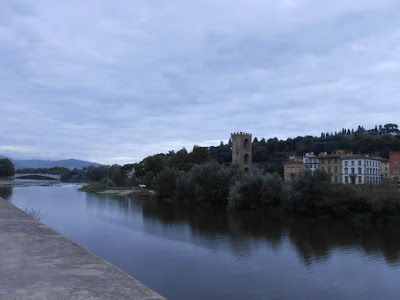We could not be late today. We were going to the Galleria dell'Accademia.
We were going to not only view but experience Michelangelo's great masterpiece,
The street filled up with eager tourists and sightseers standing in line to
see one of the world's greatest masterpieces.
Waiting in line to see
David.
Replica of David.
I took this picture in the Palazzo Vecchio.
It is a replica of the original statue of David that we viewed in
the Academy of Fine Arts.
We could not take photographs in the Accademia Gallery,
so I do not have any original photos of the statue in the gallery.
This is a photo of the full reproduction of the statue where it originally stood
at the Palazzo Vecchio.
The reproduction was made out of bronze, not marble.
The original statue was installed here in 1504.
In 1873 the original statue of David was removed from the piazza,
to protect it from damage, and displayed in the Accademia Gallery, Florence.
There is a special section in the Academy of fine Arts where the
statue is displayed. The section was made in the style of a church,
where the statue was originally to be displayed.
I took this picture in the Palazzo Vecchio.
It is a replica of the original statue of David that we viewed in
the Academy of Fine Arts.
We could not take photographs in the Accademia Gallery,
so I do not have any original photos of the statue in the gallery.
This is a photo of the full reproduction of the statue where it originally stood
at the Palazzo Vecchio.
The reproduction was made out of bronze, not marble.
The original statue was installed here in 1504.
In 1873 the original statue of David was removed from the piazza,
to protect it from damage, and displayed in the Accademia Gallery, Florence.
There is a special section in the Academy of fine Arts where the
statue is displayed. The section was made in the style of a church,
where the statue was originally to be displayed.
There is much that has been written about the magnificent statue of
David.
Our tour guide was Andre.
He was knowledgeable about Michelangelo and the statue of David.
He was moved when he talked about Michelangelo and shared his knowledge of the enormous
carving from a block of Carrara marble, one of the whitest in the world.
And, I was moved by his narrative on this subject.
He has probably given hundreds of tours to eager travelers,
and he was still deeply moved when he explained the genius of Michelangelo.
You can't look at this without being in awe.
One lady in our group started to cry while others were speechless.
No one left without an impression of the perfection of this beautiful work of art.
Below is a picture of the statue taken from this link from the Accademia Gallery in Florence.
The credit for this photo goes to,
This is a great source for more beautiful photos and information on
Michelangelo's David.
The statue is spectacular.
It took your breath away.
So much detail.
There are many people who have viewed pictures of "David",
but we experienced it.
What struck me most about this sculpture was the fact that
Michelangelo was only 26 years old
when he was commissioned to carve this massive piece of white marble.
And on top of that,
the marble was flawed.
Two other sculptors were asked to carve the block of marble but had in the end rejected due to the presence of too many “taroli”, or imperfections, which may have threatened the stability of such a huge statue. This block of marble of exceptional dimensions remained therefore neglected for 25 years, lying within the courtyard of the Opera del Duomo (Vestry Board).
(http://www.accademia.org/explore-museum/artworks/michelangelos-david/)
Also, this is not the David of the Bible depicted as a young Jewish shepherd boy.
This is a mature man.
The account of David comes from the Bible.
The account of the battle between David and Goliath is told in
Book 1 Samuel.
Saul and the Israelites are facing the Philistines near the Valley of Elah. Twice a day for 40 days, Goliath, the champion of the Philistines, comes out between the lines and challenges the Israelites to send out a champion of their own to decide the outcome in single combat. Only David, a young shepherd, accepts the challenge. Saul reluctantly agrees and offers his armor, which David declines since it is too large, taking only his sling and five stones from a brook. David and Goliath thus confront each other, Goliath with his armor and shield, David armed only with his rock, his sling, his faith in God and his courage. David hurls a stone from his sling with all his might and hits Goliath in the center of his forehead: Goliath falls on his face to the ground, and David then cuts off his head.
Traditionally, David had been portrayed by most Florentine artists after his victory,
triumphant over the slain Goliath.
Michelangelo instead, for the first time ever,
chooses to depict David before the battle.
David is tense: Michelangelo catches him at the apex of his concentration. He stands relaxed, but alert, resting on a classical pose known as contrapposto.
(http://www.accademia.org/explore-museum/artworks/michelangelos-david/)
Michelangelo's philosophy was to be
"An instrument in the hands of God."
He was.
There is much written about the genius of this masterpiece.
You will realize the greatness of this work of art if you inform yourself and read
some articles about Michelangelo and his David.
Here is a start:
I say
Genius
and
Masterpiece
many times, but truly it is.









































































































